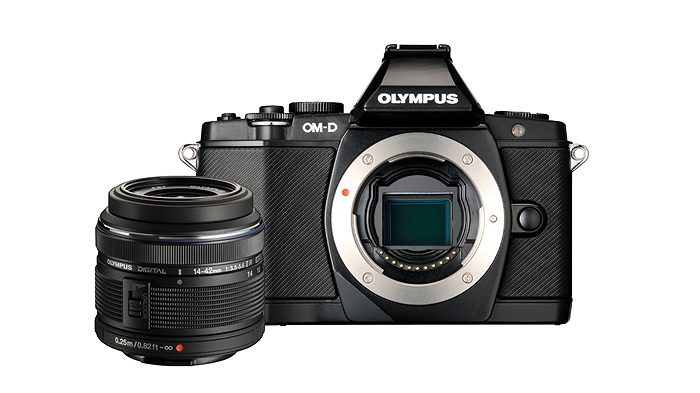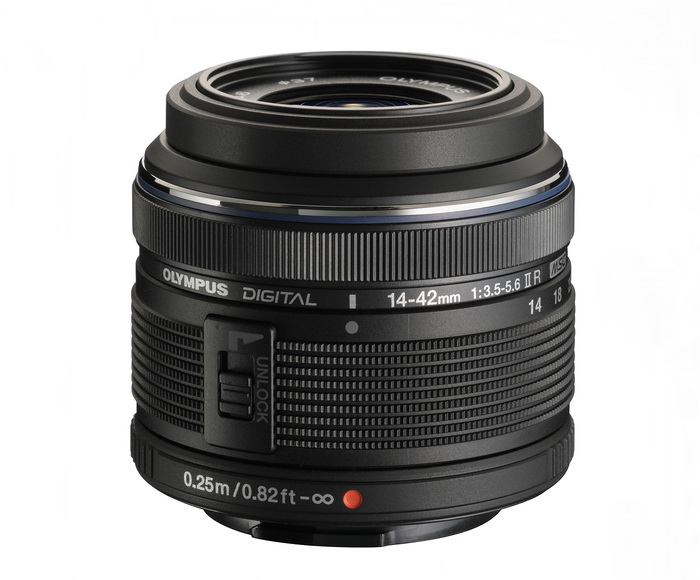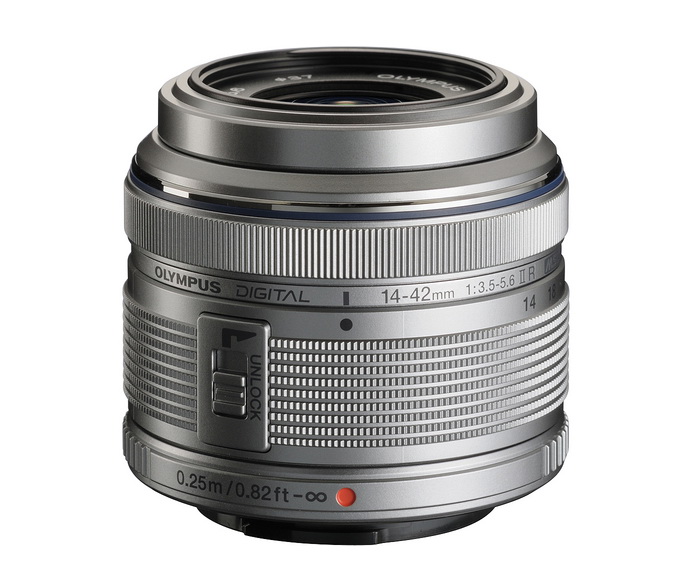 |
| Standard kit lens package with E-5M, and other cameras. |
The Olympus E-M5 was used for this review.
For a better understanding of terms and methods used in this review, go here. The usual center, mid-section and corner crops are located at the very bottom of the page.
Introduction.
The Olympus 14-42mm F/3.5-5.6 II R lens (Made in China) is a very compact lens, with a retractable design, and was introduced (upgraded from first version) in 2012. The specs for this lens says there are three aspherical elements used in its construction, see last product shot photo. This tiny lens uses a focusing system that Olympus calls ‘MSC’ or ‘movie-still-compatible’ which is basically a near silent focusing motor inside the lens, especially important for videos. In reality; the E-M5 camera whine is louder than the lens focusing system, so you’ll never hear it if you have that, or a similar camera.
Use on micro 4/3 mirrorless cameras only.
Fit and finish seem pretty good. The lens is clad in plastic, with a single plastic extension tube along with a plastic mount. Focus and zoom rings have a ribbed design etched in the plastic, and are not rubberized. Two colors are available; black and silver to match the colors of the camera bodies.
The zoom action is smooth and damped properly in my opinion, and holds its position well, so there is no zoom creep during normal use. The lens does retract for carrying but doesn’t actually lock in this position. Focal length index marks come at 14mm, 18mm, 25mm, 35mm, and 42mm. The EXIF data doesn’t always match those lengths exactly, there may be a 1 or 2mm difference, this is no big deal, I’m just pointing it out. The lens retracts from 14mm as you zoom out, and is shortest around 20mm, then extends and becomes longest at 42mm.
In the box: the lens, front and rear caps, and owner’s manual. An optional hood is available. Focusing. This MSC lens auto-focuses almost silently. Focusing seems quite accurate at all focal lengths, and reasonable quick in good light. The front filter ring doesn’t turn when focusing, so your polarizers and grads will work great.
 |
| Black |
 |
| Silver |
 |
| Optional hood |
 |
| Olympus MTF graph |
General information and specifications.
|
Lens
|
|
|
Box contents
|
Front and rear caps, possibly a matching band, and a user’s manual.
|
|
Cost
|
$299 retail as of 9/2012, or $100 extra with a camera.
|
|
Build quality
|
Good.
|
|
Additional information
|
Comes in silver or black. If purchased separately, it may come with a mount band near the front element to match the camera color.
|
|
Specifications
|
|
|
Optical configuration
|
8 elements in 7 groups
|
|
Angle of view
|
75°-29°
|
|
Aperture
|
7 blades, curved
|
| Formats |
Micro 4/3 only. With a crop factor of 2x the coverage equals 28-84mm in 135 film format.
|
|
Depth of field and focus scales?
|
Nothing.
|
|
Min. focus distance, image plane to subject @ max reproduction ratio
|
About 9.8″ (250mm)
|
|
Min. focus distance, end of lens barrel to subject @ max. reproduction ratio
|
About 6″ (155mm)
|
|
Hard stop at infinity focus?
|
No
|
|
Length changes when focusing?
|
No
|
|
Focus ring turns in AF?
|
No
|
|
Filter size
|
37mm
|
|
Filter ring rotates?
|
No
|
|
Distance encoder?
|
Yes
|
|
Max magnification
|
0.19x, or 0.38x (1:2.6) with crop factor.
|
|
Min. F/stop
|
F/22
|
|
Olympus teleconverter compatible?
|
N/A
|
|
Length changes when zooming?
|
Yes
|
|
Dimensions WxL (my measurements)
|
1.97″ x 2.20″ 50mm x 56mm. Widest at base.
|
|
Maximum extended length (my measurements)
|
2.9″ (73.5mm) longest at 42mm.
|
|
Weight bare (my scale)
|
4.0oz (113g)
|
Optical qualities summary.
Lens flare/ghosting. Some large but dull ghosts appear when super bright light sources are close to, or inside the frame. I’d recommend buying the optional hood if this is your primary lens.
Color fringing (CA). Very good control, a tiny bit of magenta and cyan along the sides of the image, but easy to remove in post processing.
Bokeh. Quite ‘busy’ at all focal lengths and longer focusing distances, but it’s hard to get anything out of focus at these short focal lengths and small apertures.
Color. Neutral.
Close up filter. N/A.
Coma. None.
Regular filters N/A
Filter size is 37mm. This small filter size is common, but a pain to try and get graduated ND filters, that’s too bad.
Distortion. You’ll notice minor barrel distortion at 14mm, and flat to slightly pincushion distortion at longer lengths. Check out the cropped samples below.
 |
| 14mm, corrected Jpeg, slight barrel distortion |
 |
| 14mm, uncorrected from RAW file |
 |
| 18mm, corrected Jpeg, minor pincushion distortion |
 |
| 25mm, corrected Jpeg, minor pincushion distortion |
 |
| 42mm, corrected Jpeg, almost straight |
Distortion is very strong in uncorrected images like RAW at 14mm, but straightens out quickly as you zoom out. There is very little in-camera distortion correction going on past 18mm. Just for clarity, the ‘corrected’ version is what comes out of the camera when saving images as jpegs.
Light fall-off.
|
14mm F/3.5
|
14mm F/3.5 uncorrected
|
|
|
|
|
42mm F/5.6
|
42mm F/5.6 uncorrected
|
|
|
|
Light fall-off is not an issue at any focal length or aperture when corrected. Uncorrected files show small to moderate amounts when the aperture is wide open.
Aperture/focal length guide.
|
Maximum aperture
|
F/3.5
|
F/3.9
|
F/4.4
|
F/5.2
|
F/5.6
|
|
Focal length
|
14mm
|
18mm
|
25mm
|
35mm
|
42mm
|
Above are the maximum apertures you’ll get at each focal length marked on the lens. Usually with kit lenses the aperture closes quickly as you just start to turn the zoom ring, but this lens goes past 18mm with only a drop of 1/3 stop, that’s pretty good.
Let’s check out the close focus capabilities of this lens.
Check out the 100% cropped portion of the full image. The sample shot was taken with the Olympus E-5M 16mp camera, so don’t compare it to others that were taken with 12 or 24mp cameras. The subject is a standard US stamp, 0.87″x 1.0″ or 22mm x 25mm. Also, note the shot was taken as close to the subject as focusing allowed; in this case a fairly short 6″ (155mm), measured from the front of the lens barrel to the subject.
This lens has a good reproduction size of 0.38x, (1:2.6) and it produced a sharp close focus shot at F/7.1. As a side note; the “1996” on the bottom left of the stamp measures a mere 1mm wide.
 |
| As close as you can get. F/7.1. click for larger image |
Now for the conclusion.
The Olympus 14-42mm F/3.5-5.6 II R kit lens offers a very compact design, with super quiet focusing, and a useful zoom range. Considering the price point of this lens, the optical performance is generally strong at the short end, say 14mm-18mm, however, it becomes slightly soft off-center at the middle focal lengths, and has a noticeable lack of contrast and resolution at the long end: about what you would expect from a standard kit lens. Ghosting and flare control are about average, which means; I’d get the hood if you decide to use the lens a lot. Distortion is kept in check by the in-camera distortion correction, and RAW shooters will be happy to know that there is not much correction going on past 18mm, and even the strong barrel distortion at 14mm is easily corrected manually in post processing. Other pluses include; the reproduction ratio is somewhat high, and it produced a pretty good close-focus shot of the standard woodpecker stamp, and there is no noticeable light fall-off at any aperture or focal length.
As a kit lens for the extra $100, I’d say it would be worth it, but buying this lens outright is not really a bargain in my opinion, unless you want a very small zoom with good results at wider focal lengths.
|
















































